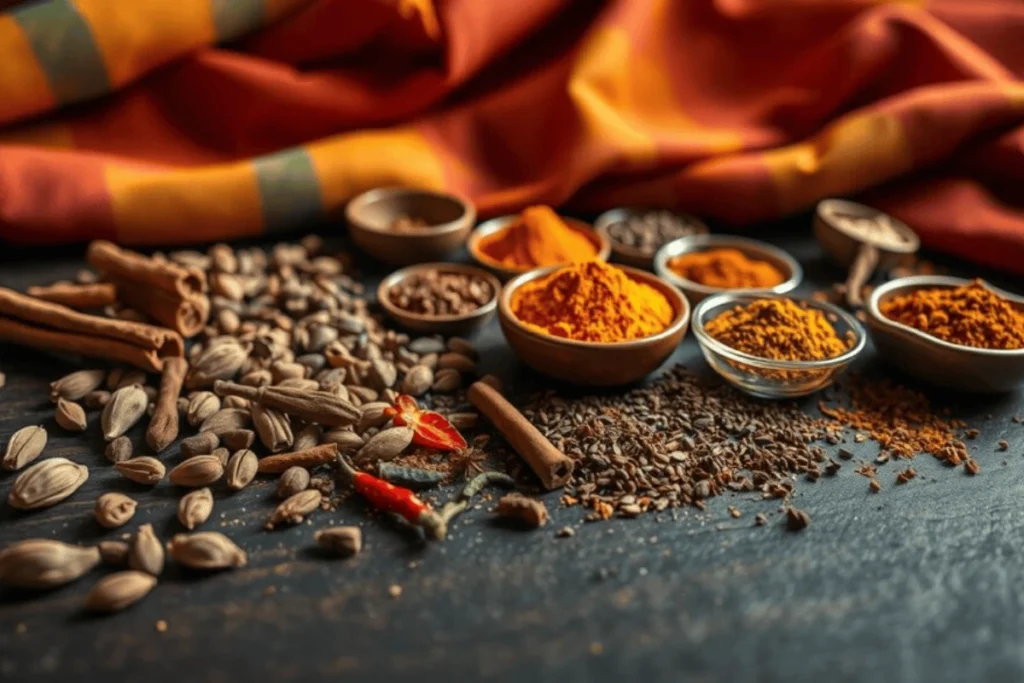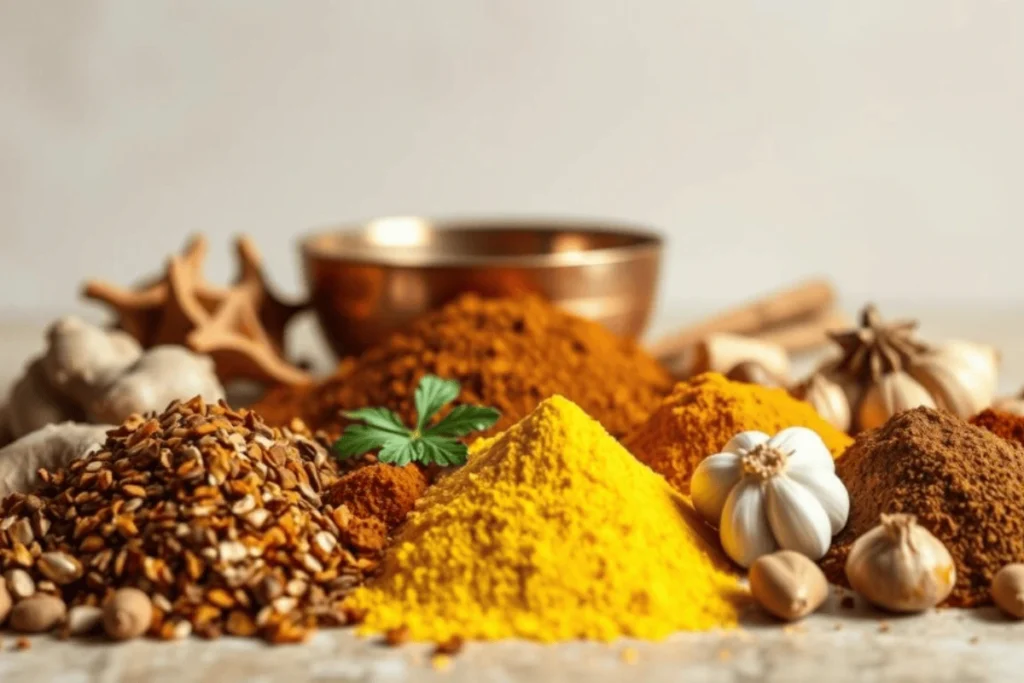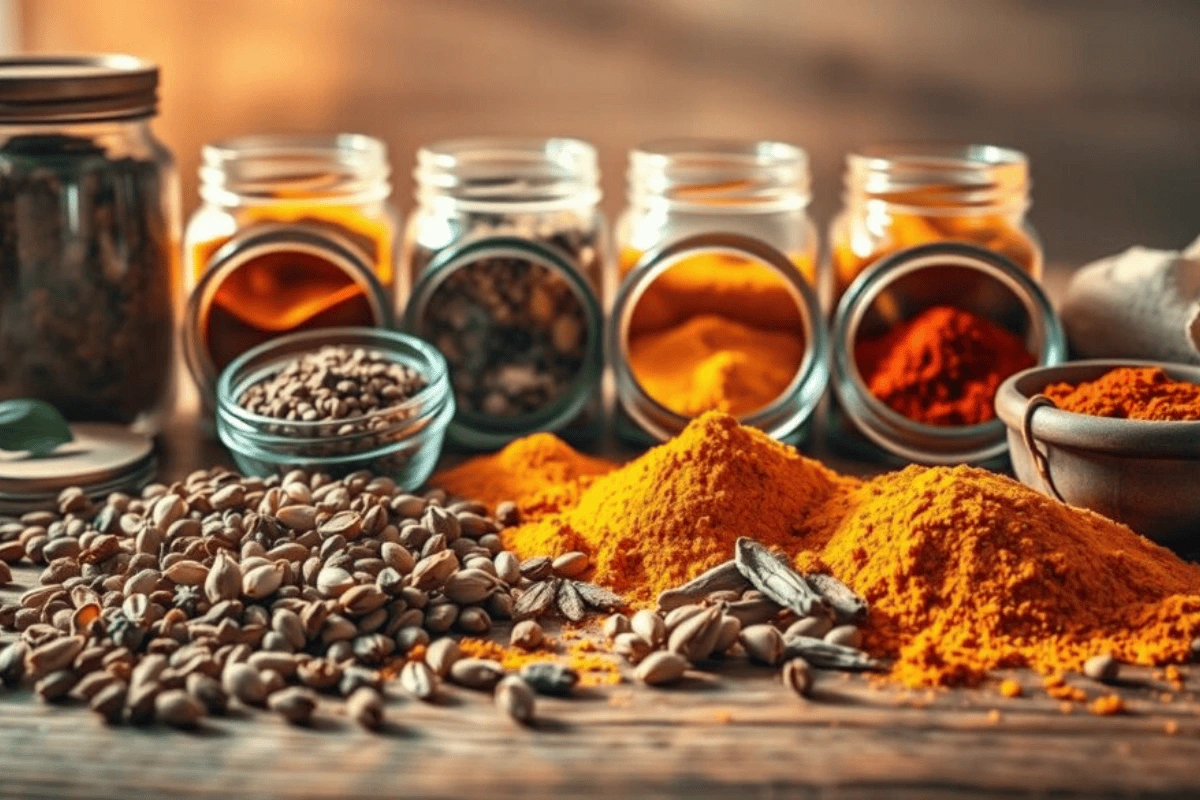Have you ever wondered how Chana Masala obtains its warm, zesty, and smoky flavor? It’s all about the Chana Masala Spice Blend . Whether you’re just starting out in the kitchen or have been cooking for a while, diving into the spices of Chana Masala gives you a sense of India’s incredible culinary landscape. This chickpea curry is incredibly simple to make, with simple yet delicious spices like cumin, coriander, and turmeric doing the heavy lifting.
Indian curry ingredients tell their stories.
Using the appropriate spices may convert basic chickpeas into a warm and intriguing dish. Consider the aroma of toasted cumin and coriander, with a touch of amchoor’s fiery kick. This combination is really simple to pick up and customize, allowing you to make it completely yours.
Remaining points
- The spices in Chana Masala, such as cumin and coriander, form a rich and flavorful basis.
- Indian curry spices such as turmeric and Kashmiri chili powder add a lovely burst of color and flavor without being overpowering.
- Understanding the fundamental spices for chana masala simplifies preparing restaurant-style dishes at home.
- Playing around with spice levels allows you to discover the ideal combination of heat and tang for your taste.
- Good storage and fresh grinding processes enhance the scent and flavor of your blends.
- Exploring the Heart of Chana Masala: A Flavor Adventure.
Chana Masala is more than simply a dinner; it’s a delicious journey through the world of Indian food. For those who are unfamiliar with Indian spices, this is a good place to start. The original spice combination brings out rich flavors while keeping it cool.
Why Chana Masala Is the Perfect Introduction to Indian Food
This dish simplifies the exploration of Indian spices. Spices like cumin, coriander, and turmeric are popular. It includes a recipe that calls for simple, readily available components.
Chana Masala allows you to experiment with spices such as fennel, mustard seeds, and asafetida.
The Flavor Profile: Getting the Right Balance of Heat, Tanginess, and Warmth
Chana Masala is all about finding the correct balance. Look at how all the pieces fit together:
Earthy vibes: Roasted cumin and coriander lay the groundwork.
Spicy: A little chili powder provides warmth without the heat.
Tangy: Amchur (dried mango powder) gives the meal a great kick.
Cinnamon and cloves provide a pleasant sense of sweetness.
This combination demonstrates how to blend flavors simply.
Regional variations in spice blends
Chana Masala differs from north to south. In Punjab, the emphasis is on the robust flavor of tomato and garam masala. Street vendors in Mumbai add more amchur for an added kick.
demonstrates how minor modifications can completely change the flavor. Giving these variations a shot is an excellent opportunity to learn traditional Indian spice blend skills.

The Essential chana masala spice blend for Your Kitchen
Getting the hang of chana masala begins with selecting the appropriate ingredients. The main spices in chana masala are what truly elevate this chickpea dish. Each spice has its own vibe. Let’s look at the necessities and flavor enhancers that every home cook should keep on hand.
| Spice | Flavor Contribution | Role in Dish |
|---|---|---|
| Cumin | Earthy, smoky | Creates depth; toasts first to amplify aroma |
| Coriander | Citrusy, sweet | Balances cumin’s intensity |
| Turmeric | Slight bitterness | Colors the dish golden and adds subtle warmth |
| Garam masala | Complex warmth (cardamom, cinnamon, cloves) | Layers spice complexity without overpowering |
| Amchoor | Dried mango powder tang | Lifts flavors like a natural acidity boost |
| Kashmiri chili | Mild heat, vibrant red hue | Colors without excessive spiciness |
Begin with the three key curry spices: cumin, coriander, and turmeric. These are the fundamentals. Add garam masala and amchoor to enhance the flavor. For a little kick, try Kashmiri chili powder. Don’t forget to collect entire spices like cumin seeds for your new batches!
- To keep things fresh, choose quality brands like Mahatma or Rancho Gordo.
- Keep in sealed containers and away from light.
- If you’re short on amchoor, simply substitute lemon juice.
These ingredients are not just for chana masala. They’re essential for recipes such as dal and paneer tikka, among others. Begin by stocking them to remove the polyvalence from your Indian food.
Cumin and Coriander: The Best Combination for Indian Curry
Cumin and coriander are key spices for preparing a great chana masala. They exude a pleasant feeling and harmony. Learn how to utilize these spices efficiently to spice up your chana masala. The smoky warmth of cumin and the lemony sharpness of coriander give this meal its distinct flavor.
Begin by toasting entire cumin seeds in oil to increase their scent. Incorporate them early to establish a robust flavor foundation. Coriander powder adds a lovely flavor later on, stopping foods from becoming bitter if cooked for too long. Find out how to use them properly:
Cumin: A Cool Base and How to Use It Properly
Whole cumin seeds have a pleasant nutty flavor. To enhance the flavor, lightly toast them in oil before grinding. Pour 1 tablespoon of cumin moulu coffee into each tasse of pois chiches. Just keep an eye on it so it doesn’t burn or become bitter.
Coriandre: Notes on Agrumes and Polyvalence.
Coriander seeds or powder add a flavorful kick to your recipes. To keep things fresh, add some ground coriander after the cumin. For a beautiful balance, use a 2:1 coriander-cumin ratio. Finish with some fresh cilantro leaves for a little more kick.
Finding the Perfect Combination of These Two Powerhouses in Your Meal
For a fantastic combination, use 1 part cumin and 2-3 parts coriander. Too much cumin might overpower the dish’s flavor. Try it as you combine, and add extra coriander if desired.
| Spice | Role | Usage Tip |
|---|---|---|
| Cumin | Earthy backbone | Toast seeds before grinding |
| Coriander | Citrusy balance | Add powdered form midway through cooking |
Experiment with different ratios to get your preferred flavor. Keep entire spices in sealed containers to keep them fresh. You’re ready to whip up a colorful chana masala with ease.
Spice Things Up: Kashmiri Chili and Other Flavor Boosters
Finding that sweet spot is essential for getting the correct amount of heat in chana masala spice blend. Begin with some Kashmiri chili powder, which is truly the star of this recipe. It provides a wonderfully rich red color without being very hot. Start with 1-2 tablespoons for a traditional, comfortable vibe, then adjust to your liking.
Kashmiri Chili Powder: A Splash of Color and Gentle Warmth.
If you want authentic Kashmiri chile, go for brands like Mahatma or Pran. It provides a moderate warmth (Scoville units: 1,000-2,000), allowing the other flavors to shine through. It really captures the typical red curry mood. To enhance the scent, roast it briefly before grinding.
Finding Your Perfect Spice Level
- Start with 1 tsp of Kashmiri chili.
- For a spicy kick, add 1⁄4 tsp cayenne, or reduce to 1⁄2 tsp for a milder flavor.
- Give it a taste here and there to see how the heat is progressing while you cook.
To temper the heat, try adding amchoor (dried mango powder) for a zesty kick.
| Option | Heat Level | Best Use |
|---|---|---|
| Green chilies (fresh) | Moderate | Blend into paste for fresh heat |
| Black pepper | Mild | Enhance depth without spiciness |
| Regular chili powder | Strong | Increase gradually for bold flavor |
Check out these interesting methods to spice up your chana masala. To tone down the spice in family dinners, simply serve with yogurt. Keep your remaining chili powder in sealed containers to keep the flavor alive.

Sidekicks: Turmeric, Garam Masala, and Amchoor.
Every traditional Indian spice blend must find that sweet spot. Turmeric, garam masala, and amchoor bring out the best in Chana Masala. They should enhance, not overshadow, the food.
Turmeric’s golden appearance and rich flavor exude warmth. However, a little too much can leave an unpleasant flavor. Simply use 1⁄2 tsp for each cup of chickpeas. Blending it with ginger helps to take the edge off.
Garam masala, a mix of cinnamon, cloves, and cardamom, offers a pleasant warmth. Grab some store-bought “Chana Masala” or make your own. Add it at the end to keep the fresh aroma going.
Amchoor: The tangy flavor of dried mango powder perfectly balances the spices. If you can’t get it, lemon juice works well as a substitute. However, amchoor is the way to go. Add it at the end to keep the flavor fresh.
Don’t forget the top curry spices, such as asafoetida (hing). A small amount of hot oil enhances the flavor and makes the food easier to digest. Kasuri methi (dry fenugreek) imparts a pleasant green flavor. Simply toss it on at the end. Begin with a small amount of new spices and adjust to your liking.
Whole vs. Ground: Maximizing Flavor with Proper Spice Preparation
To get the most out of Indian curry spices, first decide whether to use whole or ground versions. Heat causes entire spices, such as cumin seeds or mustard, to release their oils. Ground mixes provide a rapid boost of taste. Getting this proportion correct ensures that your food is not only spiced but also exploding with layers of scent and flavor.
To begin with whole spices, simply toss some cumin or fennel seeds in heated oil and let them sizzle—their aroma will indicate when they’re ready. This tempering stage (tadka) lends a comforting warmth to recipes like chana masala. Don’t overcrowd the pan; allow each seed to germinate on its own for a uniform bloom. Too many objects jammed together trap steam, preventing the desired browning.
Maintaining freshness is critical when grinding. Get a clean coffee grinder for dry-roasted spices like coriander or cardamom. Grinding too much produces fine particles that can readily catch fire. Pulse fresh spices for curry taste in short bursts to maintain texture. A mortar and pestle are ideally suited for small batches of whole peppercorns or cloves.
Combine the two forms strategically: roast whole spices first, then add ground blends later. This strategy assures that each stage of cooking adds more complexity. To conserve oil, store unused whole spices in airtight jars away from light. Proper preparation transforms simple ingredients into a vivid, restaurant-style chana masala.
Freshness Matters: Storing and Sourcing Indian Spices
Proper maintenance is required for fresh spices to shine and give curry taste. Stale spices can ruin even the most delicious recipes. Knowing how to keep Indian spices fresh is essential for both beginners and expert cooks.
Signs Your Spices Have Lost Potency
Before cooking, look for the following signs:
Color faded in comparison to the original package.
When rubbed between fingertips, it has a little smell.
Even with the precise measurements, the dish feels flat.
Best Storage Practices for Maximum Flavor.
Follow these three steps.
Transfer the spices to sealed glass jars immediately.
Store in a cool, dark cabinet away from the stove.
Replace the ground spices every 6-12 months.
Storage Method: Improved Shelf Life
Freezer preservation extends the life of entire spices by 18+ months.
Dark glass containers can maintain color and aroma for up to three times longer.
Where to Buy Quality Spices in the United States?
Best sites to buy Indian spices for beginners:
| Location Type | Top Brands/Stores |
|---|---|
| Online | Burlap & Barrel, The Spice House |
| Supermarkets | Whole Foods (pre-ground options), Walmart (bulk bins) |
| Local Markets | Indian grocers like Patel Brothers, Gourmet FoodStore |
Always check the packaging dates. Select limited batches from companies such as Rajnigandha and McCormick’s Premium line. Farmers markets frequently feature small-batch options from spice exporters such as Simply Organic.
Conclusion: Developing Your Signature chana masala spice blend
Creating your own traditional Indian spice blend for Chana Masala is essential. The base of chana masala is made up of vital spices such as cumin, coriander, and Kashmiri chili. Begin with a mixture of two parts cumin, three parts coriander, one part chile, and a pinch of turmeric.
Feel free to change the amounts to your preference. Add extra amchoor for a tangy flavor or garam spice for heat. This allows you to build a blend that is unique to you.
Never be frightened to attempt new things. For more flavor, add roasted cumin seeds or asafoetida. Keep track of your adjustments in a notepad until you find your ideal combination.
These skills are not limited to Chana Masala. They also help with other Indian dishes. Learn how to temper with whole spices, store them properly, and select high-quality ingredients. This is the beginning of your Indian cooking adventure. Begin with this blend and then confidently explore other versions.
FAQ
What spices are essential for a chana masala spice blend?
The key spices for a chana masala spice blend include cumin, coriander, turmeric, garam masala, and amchur (dried mango powder). These spices create a balance of warmth, earthiness, and tanginess, which are essential for the iconic flavor of this chickpea curry. You can adjust the proportions of each spice to suit your taste preferences.
How can I add extra heat to my chana masala spice blend?
For added spiciness, use Kashmiri chili powder or fresh green chilies. Start with a small amount and taste as you go. In this manner, you may tailor the spice to your preferences.
Is there a substitute for Indian curry spices in Chana Masala?
Yes, cumin can be replaced with caraway seeds, and curry powder can be used in place of garam masala. Remember that these adjustments may alter the flavor slightly.
How do whole spices affect the flavor of Chana Masala?
When whole spices, such as cumin seeds and cardamom, are cooked, they slowly release oils and tastes. This approach enhances the richness and perfume of your Chana Masala. They are ideally softened in oil before adding any other ingredients.
What is the best way to preserve Indian spices so they stay fresh?
Store your spices in airtight containers in a cool, dark area. Avoid sunshine and moisture, which might degrade the flavor. Check your spices frequently for symptoms of deterioration, such as dull color or a weak odor.
Where can I buy genuine Indian spices in the United States?
Quality Indian spices are available at specialty stores, online at Amazon or Patanjali, and at some farmers’ markets. Always search for fresh packaging to ensure the highest quality.
Can I create garam masala at home?
Yes, you can. Toast entire spices such as cinnamon, cloves, cardamom, and coriander seeds. Then, crush them all together to make your own garam masala. This allows you to adjust the flavor to your preferences.
What are the benefits of Indian spices?
Indian spices like turmeric, cumin, and ginger offer anti-inflammatory, antioxidant, and digestive benefits.

